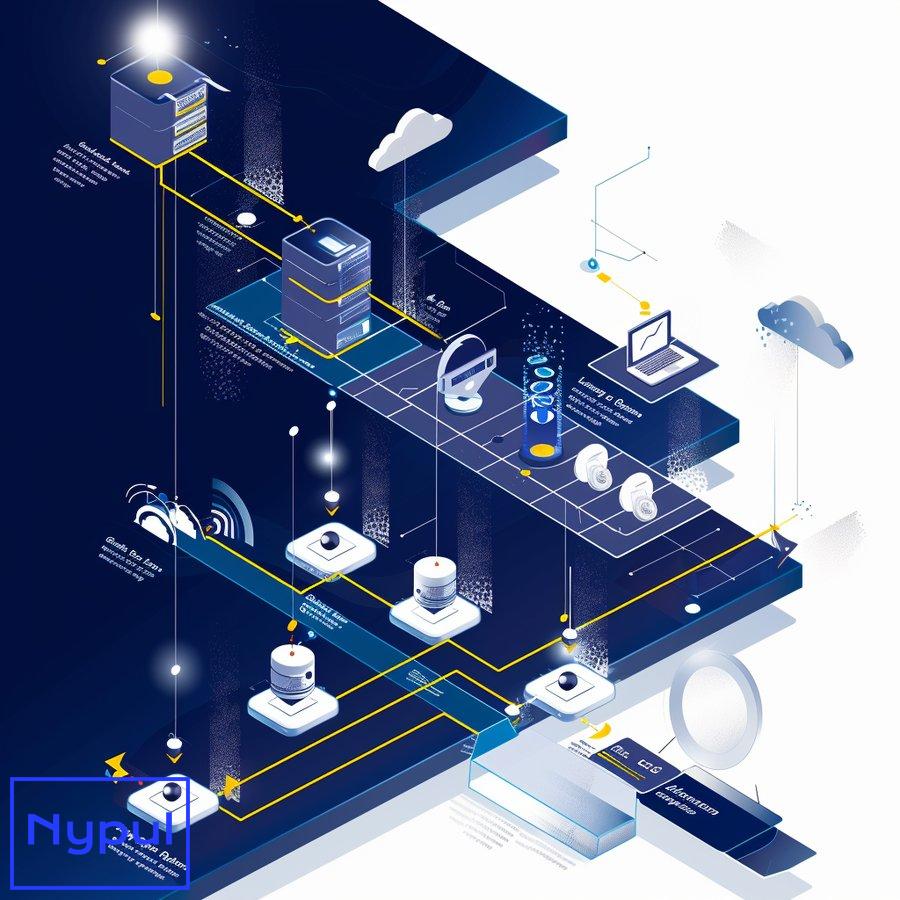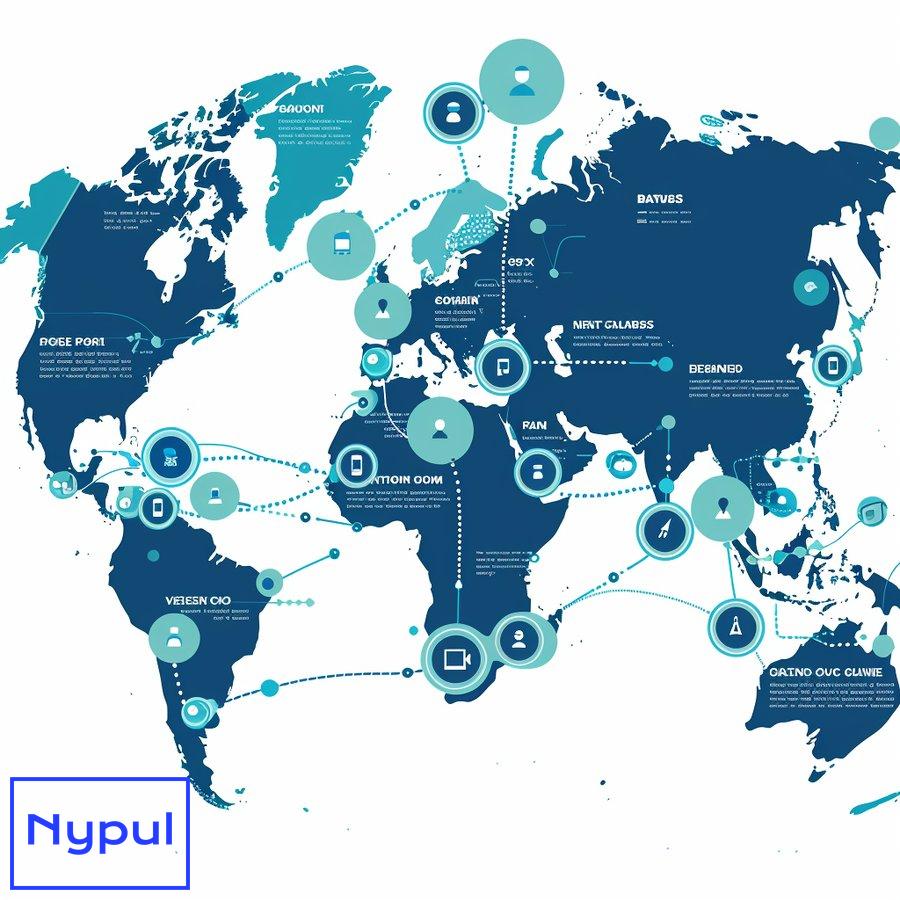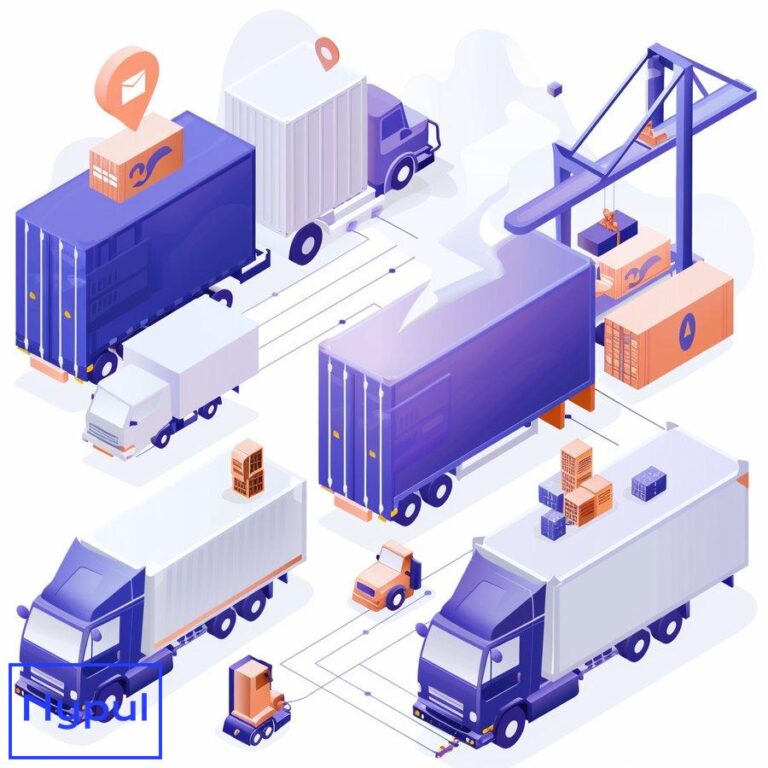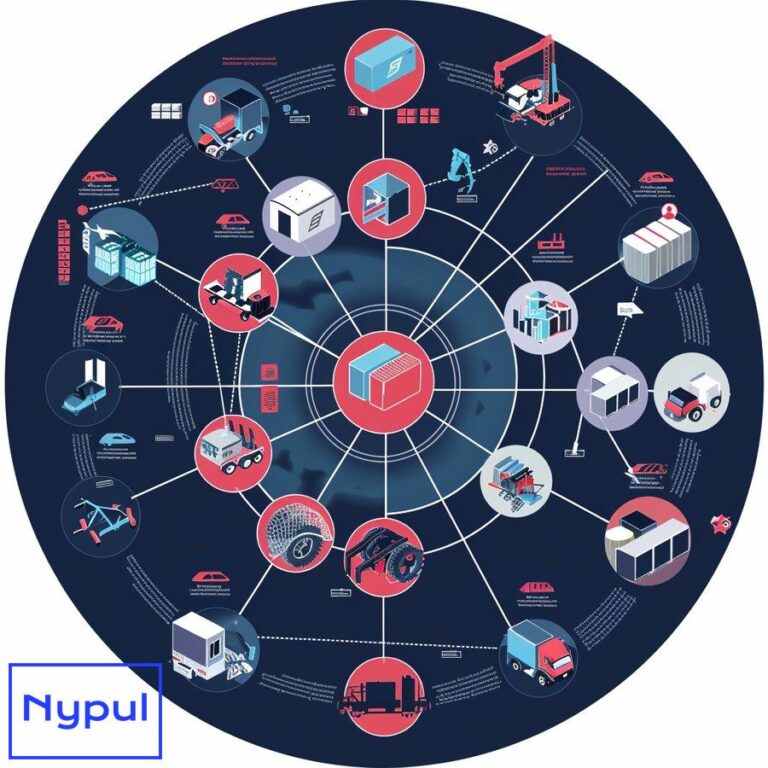Which Drayage Occurs When the Hub of Origin Is Full and Cannot Accommodate Additional Shipments
What is hub capacity and why does it matter in drayage?
Hub capacity refers to the maximum volume of freight a logistics hub can efficiently process and store at any given time. In the context of drayage operations, hub capacity plays a crucial role in determining the smooth flow of goods from ports to inland destinations.
Drayage hubs serve as critical intermediary points in the supply chain, facilitating the transfer of containers between different modes of transportation. These hubs act as buffers, allowing for the temporary storage and sorting of freight before it moves to its next destination. However, when a hub reaches or exceeds its capacity, it can lead to significant disruptions in the drayage process.
The importance of hub capacity in drayage operations cannot be overstated. A well-managed hub with adequate capacity ensures:
Efficient freight movement
Hubs with sufficient capacity can process incoming shipments quickly, reducing dwell times and keeping goods flowing smoothly through the supply chain. This efficiency is particularly crucial in time-sensitive industries where delays can result in substantial financial losses.
Cost-effective operations
Optimal hub capacity utilization allows drayage providers to maximize their resources, reducing per-unit handling costs. When hubs operate at or near capacity, they can achieve economies of scale, leading to more competitive pricing for shippers.
Reduced congestion
Adequate hub capacity helps prevent bottlenecks in the drayage process. When hubs can efficiently handle incoming freight, it reduces congestion at ports and other transportation nodes, minimizing the risk of delays and associated costs.
Enhanced flexibility
Hubs with spare capacity can better accommodate unexpected surges in freight volume or changes in shipping patterns. This flexibility is essential in today’s dynamic global trade environment, where disruptions can occur at any time.
Improved customer satisfaction
By ensuring timely processing and movement of goods, well-managed hub capacity contributes to higher levels of customer satisfaction. Shippers and consignees benefit from predictable delivery times and reduced risk of delays or damage to their cargo.
To illustrate the impact of hub capacity on drayage operations, consider the following table comparing the performance of hubs operating at different capacity levels:
| Capacity Utilization | Average Dwell Time | Throughput (containers/day) | Operating Costs (per container) |
|---|---|---|---|
| 70% | 1 day | 1000 | $100 |
| 85% | 1.5 days | 1200 | $90 |
| 95% | 2.5 days | 1300 | $85 |
| >100% | 4+ days | 1100 | $110 |
As the table demonstrates, hubs operating at optimal capacity (around 85%) can achieve a balance between high throughput and reasonable dwell times while maintaining cost-effectiveness. However, when capacity utilization exceeds 95%, dwell times increase significantly, and operational efficiency begins to decline.
Understanding and managing hub capacity is essential for drayage providers, shippers, and logistics planners. By maintaining appropriate capacity levels, stakeholders can ensure the smooth flow of goods, minimize costs, and enhance overall supply chain performance. In the following sections, we will explore strategies for addressing capacity challenges, including the implementation of shuttle drayage operations.
How does shuttle drayage address full hub challenges?
Shuttle drayage emerges as a strategic solution when logistics hubs face capacity constraints. This specialized form of drayage involves the temporary relocation of freight to secondary storage facilities or staging areas when the primary hub reaches its maximum capacity. By implementing shuttle drayage, logistics providers can effectively manage overflow situations and maintain the flow of goods through the supply chain.
Alleviating congestion
Shuttle drayage directly addresses the issue of hub congestion by providing an alternative destination for incoming freight. When a primary hub reaches capacity, containers can be diverted to nearby temporary storage facilities. This redirection prevents bottlenecks at the main hub and allows for continued processing of incoming shipments.
Maintaining operational efficiency
By utilizing shuttle drayage, logistics providers can maintain a high level of operational efficiency even when faced with capacity challenges. The primary hub can continue to function at optimal levels, while the overflow is managed through shuttle operations. This approach helps prevent the slowdowns and increased dwell times typically associated with overcapacity situations.
Enhancing flexibility
Shuttle drayage introduces an element of flexibility into the drayage process. It allows logistics providers to adapt quickly to sudden surges in freight volume or unexpected delays in outbound transportation. This flexibility is particularly valuable in today’s volatile global trade environment, where disruptions can occur with little warning.
Cost management
While shuttle drayage does incur additional transportation costs, it can be a cost-effective solution when compared to the alternatives. The expenses associated with shuttle operations are often lower than the potential demurrage charges, lost business, or inefficiencies that would result from a severely congested primary hub.
Improved customer service
By preventing delays and maintaining the flow of goods, shuttle drayage contributes to improved customer satisfaction. Shippers and consignees benefit from more predictable transit times and reduced risk of cargo damage or loss due to overcrowding at the primary hub.
To illustrate the impact of shuttle drayage on hub operations, consider the following comparison:
| Metric | Without Shuttle Drayage | With Shuttle Drayage |
|---|---|---|
| Hub Capacity Utilization | >100% | 85-90% |
| Average Dwell Time | 4+ days | 1.5-2 days |
| Daily Throughput | Decreased by 15-20% | Maintained or increased |
| Demurrage Charges | High | Significantly reduced |
| Customer Satisfaction | Low due to delays | Improved due to consistent service |
The table clearly demonstrates the benefits of implementing shuttle drayage when facing hub capacity challenges. By maintaining optimal capacity utilization and reducing dwell times, shuttle drayage helps preserve operational efficiency and customer satisfaction.
Implementation considerations
While shuttle drayage offers significant benefits, its successful implementation requires careful planning and coordination. Logistics providers must consider factors such as:
Proximity of secondary facilities
The effectiveness of shuttle drayage depends on the availability of suitable temporary storage facilities within a reasonable distance from the primary hub. These facilities should be strategically located to minimize additional transportation costs and time.
Equipment and resource allocation
Implementing shuttle drayage may require additional equipment, such as trucks and chassis, as well as personnel to manage the secondary facilities. Providers must ensure they have the necessary resources to support shuttle operations without compromising service at the primary hub.
Information systems integration
Effective shuttle drayage relies on robust information systems that can track and manage the movement of freight between the primary hub and secondary facilities. Integration with existing warehouse management and transportation management systems is crucial for maintaining visibility and control over shuttle operations.
Regulatory compliance
Depending on the location and nature of the goods being transported, shuttle drayage operations may be subject to additional regulatory requirements. Providers must ensure compliance with all relevant local, state, and federal regulations governing the movement and storage of freight.
By addressing these implementation considerations and leveraging the benefits of shuttle drayage, logistics providers can effectively manage hub capacity challenges and maintain the smooth flow of goods through the supply chain. In the next section, we will explore the key components required for successful implementation of shuttle drayage operations.
What are the key components of implementing shuttle drayage operations?
Implementing successful shuttle drayage operations requires careful planning and coordination of several key components. These elements work together to ensure the smooth flow of freight between the primary hub and secondary facilities, maintaining operational efficiency and customer satisfaction. Let’s explore the essential components of an effective shuttle drayage system:
Strategic facility selection
Choosing appropriate secondary facilities is crucial for the success of shuttle drayage operations. These facilities should be:

- Located within a reasonable distance from the primary hub to minimize transportation time and costs
- Equipped with adequate storage capacity and handling equipment
- Compliant with relevant safety and security regulations
- Accessible to various transportation modes for efficient onward movement of freight
The strategic placement of these facilities can significantly impact the overall effectiveness of shuttle drayage operations.
Robust transportation network
A well-organized transportation network forms the backbone of shuttle drayage operations. This network should include:
- A fleet of reliable trucks suitable for short-haul operations
- Sufficient chassis and other equipment to handle various container types
- Experienced drivers familiar with local routes and regulations
- Efficient scheduling and dispatch systems to optimize vehicle utilization
The transportation network must be flexible enough to respond quickly to changing demand patterns and hub capacity fluctuations.
Advanced information systems
Effective shuttle drayage relies heavily on real-time information flow and visibility. Key information system components include:
- Integrated warehouse management systems (WMS) for both primary and secondary facilities
- Transportation management systems (TMS) for optimizing route planning and scheduling
- Real-time tracking and tracing capabilities for containers and vehicles
- Data analytics tools for performance monitoring and optimization
These systems should seamlessly integrate to provide a comprehensive view of shuttle drayage operations across all facilities and transportation modes.
Skilled workforce
A competent and well-trained workforce is essential for managing shuttle drayage operations. Key personnel requirements include:
- Experienced logistics coordinators to manage the flow of freight between facilities
- Skilled warehouse staff for efficient handling and storage of goods at secondary facilities
- Knowledgeable customer service representatives to handle inquiries and resolve issues
- Data analysts to monitor performance metrics and identify areas for improvement
Ongoing training and development programs are crucial to maintain a high level of skill and adaptability among the workforce.
Effective communication protocols
Clear and efficient communication is vital for coordinating shuttle drayage operations. Essential communication components include:
- Standardized procedures for information sharing between primary and secondary facilities
- Regular status updates and performance reports for stakeholders
- Clearly defined escalation processes for handling exceptions and emergencies
- Collaborative platforms for real-time communication between team members and partners
Establishing robust communication protocols helps ensure smooth coordination and rapid response to changing conditions.
Performance monitoring and optimization
Continuous improvement is key to maintaining the efficiency of shuttle drayage operations. Important elements of performance management include:
- Defined key performance indicators (KPIs) for measuring operational efficiency
- Regular performance reviews and benchmarking against industry standards
- Feedback mechanisms for identifying bottlenecks and areas for improvement
- Continuous process optimization based on data-driven insights
By consistently monitoring and optimizing performance, shuttle drayage operations can adapt to changing conditions and maintain high levels of efficiency.
Regulatory compliance framework
Ensuring compliance with relevant regulations is crucial for the smooth operation of shuttle drayage services. Key components of a compliance framework include:
- Comprehensive understanding of local, state, and federal regulations governing freight movement and storage
- Regular audits and inspections to ensure ongoing compliance
- Documentation and record-keeping systems to support compliance efforts
- Training programs to keep staff updated on regulatory requirements and best practices
A robust compliance framework helps minimize the risk of legal issues and operational disruptions.
To illustrate the interplay between these key components, consider the following table outlining the responsibilities and interactions within a shuttle drayage operation:
| Component | Primary Responsibility | Key Interactions |
|---|---|---|
| Strategic Facility Selection | Senior Management | Transportation Network, Regulatory Compliance |
| Transportation Network | Operations Manager | Information Systems, Workforce |
| Information Systems | IT Department | All Other Components |
| Workforce | Human Resources | All Other Components |
| Communication Protocols | Operations Manager | All Other Components |
| Performance Monitoring | Data Analytics Team | All Other Components |
| Regulatory Compliance | Legal Department | All Other Components |
This table demonstrates the interconnected nature of shuttle drayage components and the need for seamless coordination across all aspects of the operation.
By carefully implementing and managing these key components, logistics providers can establish efficient and effective shuttle drayage operations. This approach allows them to address hub capacity challenges while maintaining high levels of service and operational efficiency. In the next section, we will explore how shuttle drayage compares to alternative solutions for managing hub overflow situations.
How do alternative solutions compare to shuttle drayage for hub overflow?
When faced with hub capacity challenges, logistics providers have several options beyond shuttle drayage. Understanding how these alternatives compare is crucial for making informed decisions about managing hub overflow. Let’s examine some of the key alternative solutions and compare them to shuttle drayage:
Extended hub hours
One approach to managing overflow is to extend the operating hours of the primary hub. This solution aims to increase throughput by processing freight over a longer period each day.

Comparison to shuttle drayage:
– Advantages: Utilizes existing facilities and equipment, potentially lower implementation costs
– Disadvantages: May incur higher labor costs, limited by staff availability and fatigue concerns
Shuttle drayage offers greater flexibility and scalability compared to extended hours, especially during prolonged periods of high volume.
Temporary storage containers
Another option involves using temporary storage containers or trailers at the primary hub to increase short-term capacity.
Comparison to shuttle drayage:
– Advantages: Keeps freight on-site, potentially faster retrieval times
– Disadvantages: Limited by available space at the primary hub, may create congestion in the yard
Shuttle drayage provides a more organized and scalable solution, especially for larger volumes of overflow freight.
Cross-docking
Cross-docking involves transferring freight directly from inbound to outbound transportation with minimal storage time.
Comparison to shuttle drayage:
– Advantages: Reduces storage requirements, can speed up transit times for some freight
– Disadvantages: Requires precise coordination, may not be suitable for all types of cargo
Shuttle drayage offers more flexibility in handling various cargo types and dealing with longer-term capacity issues.
Expansion of primary hub
A long-term solution to capacity challenges is the physical expansion of the primary hub facility.
Comparison to shuttle drayage:
– Advantages: Provides a permanent increase in capacity, can be tailored to specific needs
– Disadvantages: High capital investment, time-consuming to implement, may face regulatory hurdles
Shuttle drayage offers a more immediate and flexible solution without the need for significant capital investment.
Diversion to alternate hubs
This approach involves redirecting freight to other existing hubs within the network when the primary hub reaches capacity.
Comparison to shuttle drayage:
– Advantages: Utilizes existing facilities and systems within the network
– Disadvantages: May increase transportation costs and transit times, potential for disruption to established routes
Shuttle drayage provides a more localized solution, maintaining proximity to the original destination and minimizing disruption to existing routes.
To provide a comprehensive comparison of these alternatives with shuttle drayage, consider the following table:
| Solution | Implementation Time | Scalability | Cost | Flexibility | Impact on Operations |
|---|---|---|---|---|---|
| Shuttle Drayage | Medium | High | Medium | High | Minimal disruption |
| Extended Hub Hours | Short | Low | Medium-High | Low | Potential staff burnout |
| Temporary Storage | Short | Medium | Low-Medium | Medium | Yard congestion |
| Cross-Docking | Medium | Medium | Medium | Medium | Requires precise coordination |
| Hub Expansion | Long | High | High | Low | Significant during construction |
| Alternate Hubs | Medium | Medium | Medium-High | Medium | Route disruption |
This comparison highlights the balanced approach offered by shuttle drayage, providing a good mix of scalability, flexibility, and operational impact.
Factors influencing solution selection
When choosing between shuttle drayage and alternative solutions, logistics providers must consider several factors:
Volume and duration of overflow
The expected volume and duration of the capacity challenge play a crucial role in solution selection. Shuttle drayage is particularly well-suited for handling medium to large volumes over extended periods.
Available resources
The existing infrastructure, equipment, and workforce availability influence the feasibility of different solutions. Shuttle drayage may require additional resources but offers greater scalability.
Cost considerations
Both immediate and long-term costs should be evaluated. While shuttle drayage may have higher operational costs, it avoids the significant capital investment required for hub expansion.
Regulatory environment
Local regulations and zoning restrictions may limit the viability of certain solutions. Shuttle drayage operations must comply with relevant transportation and storage regulations.
Customer requirements
The specific needs and expectations of customers, including delivery timeframes and special handling requirements, should be considered when selecting an overflow solution.
Long-term strategy
The chosen solution should align with the company’s long-term growth and operational strategies. Shuttle drayage offers flexibility to adapt to changing market conditions.
By carefully evaluating these factors and comparing the available options, logistics providers can determine whether shuttle drayage or an alternative solution best addresses their specific hub overflow challenges. In many cases, a combination of approaches may be most effective in managing capacity issues while maintaining operational efficiency and customer satisfaction.
In the next section, we will explore the broader impact of hub overflow on supply chain efficiency and how effective management strategies, including shuttle drayage, can mitigate these effects.
What impact does hub overflow have on supply chain efficiency?
Hub overflow situations can have far-reaching consequences on supply chain efficiency, affecting not only the immediate logistics operations but also the broader network of suppliers, manufacturers, and end customers. Understanding these impacts is crucial for developing effective strategies to manage capacity challenges and maintain overall supply chain performance.
Increased dwell times
One of the most immediate effects of hub overflow is the increase in dwell times for freight at the congested facility. This extended storage period can lead to:
- Higher inventoryIncreased dwell times
One of the most immediate effects of hub overflow is the increase in dwell times for freight at the congested facility. This extended storage period can lead to:
- Higher inventory holding costs for shippers, as goods remain in limbo longer than anticipated.
- Increased risk of cargo damage or spoilage, especially for perishable goods.
- Reduced availability of containers for outbound shipments, leading to further delays.
Disruption of scheduled operations
Overflow situations can disrupt the carefully planned schedules of logistics providers. When a hub cannot accommodate additional shipments, it can lead to:
- Rescheduling of deliveries and pickups, creating a ripple effect throughout the supply chain.
- Increased reliance on expedited shipping methods, which can drive up costs and reduce profitability.
- Strain on relationships with customers who expect timely deliveries, potentially leading to dissatisfaction and loss of business.
Bottlenecks in the supply chain
When a hub reaches capacity, it creates bottlenecks that can hinder the flow of goods throughout the entire supply chain. This can result in:
- Delays in receiving raw materials or components, impacting production schedules and overall manufacturing efficiency.
- Increased lead times for end customers, which can affect service levels and competitiveness in the market.
- Greater difficulty in managing inventory levels, leading to either excess stock or stockouts.
Increased transportation costs
Overflow situations often necessitate alternative transportation arrangements, which can drive up costs. The implications include:
- Higher freight rates due to the need for expedited services or rerouting shipments to alternate hubs.
- Increased labor costs associated with managing overflow operations and handling additional logistics challenges.
- Potential demurrage charges incurred when containers remain at ports or terminals longer than allowed.
Impact on service levels
The cumulative effects of hub overflow on supply chain efficiency can severely impact service levels. Key consequences include:
- Longer delivery times that may not meet customer expectations, leading to dissatisfaction and potential loss of business.
- Difficulty in maintaining consistent communication with customers regarding shipment statuses, further eroding trust and reliability.
- Challenges in meeting contractual obligations related to delivery timelines and service quality.
To better understand these impacts, consider the following table summarizing how hub overflow affects various aspects of supply chain efficiency:
| Impact Area | Effect of Hub Overflow |
|---|---|
| Dwell Times | Increased inventory holding costs; higher risk of damage |
| Scheduled Operations | Disruptions leading to rescheduling; reliance on expedited shipping |
| Bottlenecks | Delays in raw material receipt; increased lead times for customers |
| Transportation Costs | Higher freight rates; increased labor costs; potential demurrage charges |
| Service Levels | Longer delivery times; challenges in communication; unmet contractual obligations |
By recognizing these impacts, logistics providers can better appreciate the importance of effective hub capacity management strategies. Implementing solutions such as shuttle drayage can help mitigate these challenges by maintaining operational efficiency and ensuring timely movement of goods.
How can predictive analytics improve hub capacity management?
Predictive analytics has emerged as a powerful tool for enhancing hub capacity management within drayage operations. By leveraging data-driven insights, logistics providers can make informed decisions that optimize capacity utilization and improve overall efficiency. Here are several ways predictive analytics contributes to effective hub capacity management:
Demand forecasting
Predictive analytics enables logistics providers to analyze historical data and identify patterns in freight volume fluctuations. By accurately forecasting demand, providers can:
- Anticipate peak periods and adjust staffing levels accordingly.
- Optimize equipment allocation based on expected container flows.
- Implement proactive measures to prevent overflow situations before they occur.
Capacity planning
With insights gained from predictive analytics, logistics providers can develop more effective capacity planning strategies. This includes:
- Identifying optimal capacity thresholds based on historical performance metrics.
- Simulating various scenarios to assess the impact of different demand levels on hub operations.
- Making data-informed decisions about when to implement shuttle drayage or other overflow solutions.
Real-time monitoring
Predictive analytics tools allow for real-time monitoring of hub operations, enabling logistics providers to respond swiftly to changing conditions. Key benefits include:
- Immediate identification of capacity constraints as they arise, facilitating timely intervention.
- Enhanced visibility into container movements and dwell times, allowing for better resource allocation.
- Improved communication with stakeholders regarding potential delays or disruptions.
Performance optimization
By continuously analyzing operational data, predictive analytics helps identify areas for improvement within hub operations. This includes:
- Tracking key performance indicators (KPIs) related to capacity utilization and dwell times.
- Identifying bottlenecks or inefficiencies that may be contributing to overflow situations.
- Implementing data-driven process improvements that enhance overall operational efficiency.
Scenario analysis
Predictive analytics allows logistics providers to conduct scenario analyses that model various “what-if” situations. This capability enables them to:
- Assess the potential impact of external factors such as economic fluctuations or changes in shipping patterns on hub capacity.
- Evaluate the effectiveness of different overflow solutions under various conditions, including shuttle drayage versus alternative approaches.
- Develop contingency plans that ensure resilience in the face of unexpected challenges.
To illustrate how predictive analytics enhances hub capacity management, consider the following table comparing traditional management approaches with those utilizing predictive analytics:
| Approach | Traditional Management | Predictive Analytics |
|---|---|---|
| Demand Forecasting | Reactive based on past trends | Proactive with data-driven insights |
| Capacity Planning | Static thresholds | Dynamic simulations based on real-time data |
| Monitoring | Periodic checks | Continuous real-time tracking |
| Performance Optimization | Manual reviews | Automated data analysis for continuous improvement |
| Scenario Analysis | Limited flexibility | Comprehensive modeling for informed decision-making |
This comparison highlights the significant advantages offered by predictive analytics in managing hub capacity effectively.
By embracing predictive analytics as part of their capacity management strategy, logistics providers can enhance their ability to anticipate demand fluctuations, optimize resource allocation, and improve overall operational efficiency. In doing so, they position themselves to address hub overflow challenges proactively while maintaining high service levels.
What real-world examples demonstrate successful overflow management?
Several organizations have successfully implemented strategies to manage hub overflow effectively through innovative approaches such as shuttle drayage and predictive analytics. These real-world examples illustrate how proactive measures can enhance operational efficiency and mitigate the impacts of capacity challenges.

Example 1: Port Authority X – Shuttle Drayage Implementation
Port Authority X faced significant congestion issues due to increasing container volumes during peak seasons. To address this challenge, they implemented a shuttle drayage program that involved partnering with local warehouses for temporary storage solutions.
Key outcomes included:
-
Reduced Dwell Times: The average dwell time at the primary port facility decreased from 3 days to 1 day due to effective diversion of overflow containers.
-
Increased Throughput: The port’s throughput improved by 25% during peak seasons as shuttle drayage allowed for more efficient processing of incoming shipments.
-
Enhanced Customer Satisfaction: Clients reported improved delivery times and reduced demurrage charges due to better management of container flows.
This case demonstrates how strategic partnerships and shuttle drayage implementation can alleviate congestion at critical hubs while enhancing overall performance.
Example 2: Logistics Company Y – Predictive Analytics Integration
Logistics Company Y integrated predictive analytics into its operations to improve hub capacity management across its network. By analyzing historical shipment data and using advanced algorithms for demand forecasting, they achieved significant improvements.
Key outcomes included:
-
Accurate Demand Forecasting: The company reduced forecasting errors by 30%, allowing them to better prepare for peak shipping periods.
-
Optimized Resource Allocation: Real-time monitoring enabled dynamic adjustments to staffing levels and equipment deployment based on anticipated demand fluctuations.
-
Cost Savings: By minimizing reliance on expedited shipping methods during peak periods, Logistics Company Y achieved a 15% reduction in transportation costs.
This example illustrates how leveraging data-driven insights can lead to more effective decision-making and improved operational efficiency within logistics networks.
Example 3: Retailer Z – Cross-Docking Strategy
Retailer Z faced challenges with inventory overflow at its distribution center due to seasonal spikes in demand. To address this issue, they implemented a cross-docking strategy combined with shuttle drayage capabilities.
Key outcomes included:
-
Streamlined Operations: By transferring goods directly from inbound trucks to outbound shipments with minimal storage time, Retailer Z reduced handling costs by 20%.
-
Improved Inventory Turnover: The retailer achieved a faster inventory turnover rate by minimizing excess stock held at their distribution center during peak seasons.
-
Enhanced Customer Service: Customers experienced shorter lead times for product availability due to more efficient processing at the distribution center.
This case highlights how combining cross-docking with shuttle drayage can effectively manage inventory overflow while maintaining high service levels.
These examples demonstrate that successful overflow management requires a combination of strategic planning, innovative solutions like shuttle drayage, and data-driven insights through predictive analytics. By adopting these approaches, organizations can enhance their operational efficiency and resilience against future capacity challenges.
How are automation and AI transforming drayage and hub management?

The integration of automation and artificial intelligence (AI) into drayage and hub management is revolutionizing logistics operations. These technologies offer numerous benefits that enhance efficiency, reduce costs, and improve overall service quality. Here are several ways automation and AI are transforming this sector:
Automated container handling systems
Automation technologies have led to the development of advanced container handling systems at ports and hubs. These systems include automated cranes and robotic vehicles that streamline cargo loading and unloading processes. Key benefits include:
-
Increased Efficiency: Automated systems operate faster than manual processes, significantly reducing turnaround times for vessels and trucks.
-
Reduced Labor Costs: Automation minimizes reliance on manual labor for repetitive tasks while allowing human workers to focus on higher-value activities such as oversight and maintenance.
AI-driven demand forecasting
AI algorithms analyze vast amounts of historical data from various sources (e.g., shipping patterns, weather conditions) to generate accurate demand forecasts. This capability enables logistics providers to:
-
Anticipate Capacity Needs: AI-driven insights help identify trends that inform resource allocation decisions ahead of time.
-
Optimize Inventory Levels: Improved forecasting reduces excess inventory holding costs while ensuring adequate stock availability during peak periods.
Smart routing algorithms
AI-powered routing algorithms optimize transportation routes based on real-time traffic conditions, weather forecasts, and other variables affecting delivery schedules. Benefits include:
-
Reduced Transit Times: Smart routing minimizes delays caused by congestion or adverse weather conditions by dynamically adjusting routes based on current conditions.
-
Lower Transportation Costs: Efficient routing leads to reduced fuel consumption and lower operating expenses associated with transportation.
Predictive maintenance
Automation combined with AI enables predictive maintenance strategies that monitor equipment health in real time. This proactive approach helps logistics providers:
-
Minimize Downtime: Early identification of potential equipment failures allows for timely maintenance interventions before breakdowns occur.
-
Extend Equipment Lifespan: Regular maintenance based on usage patterns ensures optimal performance over time while reducing replacement costs.
Enhanced visibility through IoT integration
The Internet of Things (IoT) facilitates real-time tracking of containers throughout the supply chain via connected devices embedded within cargo units or vehicles. Key advantages include:
-
Improved Transparency: IoT-enabled tracking provides stakeholders with up-to-date information about cargo location and status throughout transit.
-
Data-driven Decision Making: Enhanced visibility allows logistics providers to make informed decisions regarding resource allocation based on real-time conditions affecting their operations.
To summarize how automation and AI are transforming drayage operations compared with traditional methods, consider the following table:
| Aspect | Traditional Methods | Automation & AI Integration |
|---|---|---|
| Container Handling | Manual processes prone to delays | Automated systems increasing speed |
| Demand Forecasting | Historical trends without real-time adjustments | AI-driven forecasts improving accuracy |
| Routing Efficiency | Static routes based on historical data | Smart routing adapting dynamically |
| Maintenance Strategies | Reactive maintenance schedules | Predictive maintenance minimizing downtime |
| Visibility & Tracking | Limited visibility into cargo status | IoT-enabled tracking providing real-time updates |
This comparison highlights significant improvements brought about by automation and AI technologies within drayage operations.
As logistics providers continue adopting automation technologies alongside AI applications into their operations—especially concerning hub management—they position themselves favorably within an increasingly competitive landscape characterized by rising customer expectations regarding speediness along with cost-effectiveness while ensuring resilience against disruptions caused by unforeseen events such as natural disasters or pandemics alike!
In conclusion, embracing these advancements will be critical for organizations aiming not only towards optimizing their existing processes but also preparing themselves adequately against future uncertainties impacting global trade dynamics!





